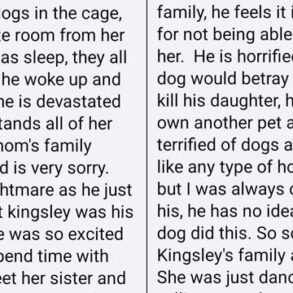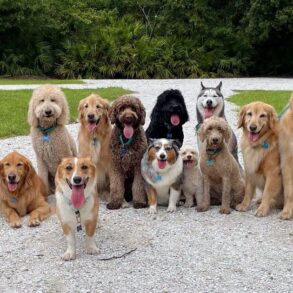
The death of Ollie, a 9-month-old labradoodle mauled at a Massachusetts pet care facility in 2020, led the state this October to enact the stringent “Ollie’s Law,” tightening regulations on the care and housing of pets at boarding and training kennels.
The new Massachusetts law mandates the timely reporting of such incidents to local authorities. It also empowers state regulators to come up with new rules that may require that dogs be housed with similarly sized animals and not be left without human supervision, as Ollie was, according to his owner.
A few other states — including Colorado and Iowa — have regulations in place, but most states rely on local rules or have no regulations at all for pet care facilities, according to Jeremy Cohen, an attorney who founded Boston Dog Lawyers. His firm represents pet owners in cases ranging from custody in a divorce, to injury and wrongful deaths, to defense of dogs that bit someone. (He did not represent Ollie’s owner, who did not file a suit.)
Opponents of new regulations say the rules may make it more expensive to operate the facilities and could hurt small businesses. Facing such opposition, recent legislative efforts to tighten rules have failed to advance in other states, including Kansas and Washington.
That leaves some pet owners without assurances that the facilities they trust to care for their pets are operating under certain standards, said Cohen, who pushed for the new Massachusetts law.
“Pet owners don’t know until something happens,” he said. “And they are shocked to find out there are no regulations. [Pet care facilities] can stay under the radar until something happens.”
That was the situation facing Ollie’s owner, Amy Baxter. She dropped off Ollie, who was 7 months old, at a doggie day care center in East Longmeadow and later received a call that her pet had been hurt in a dog fight, she said in an interview.
The center, which she said was unlicensed and which has since closed, did not notify local authorities of the incident nor immediately take Ollie to a vet. He died two months later after multiple surgeries.
Baxter, a former legislative aide in New York state, gathered a coalition of pet owners, kennel operators and animal protection groups and spent several years lobbying the Massachusetts legislature for new rules. Massachusetts Democratic Gov. Maura Healey signed “Ollie’s Law” in October.
The law limits the number of dogs that can be cared for in a single facility and requires recordkeeping, inspections and reporting of pet injuries and deaths. The precise rules on staff-to-animal ratios, dog group sizes and supervision, emergency planning, minimum housing and care requirements, and staff training and insurance will be written by the state’s Department of Agricultural Resources over the next 18 months.
The National Humane Education Society said the Massachusetts law sets “a new standard” in kennel regulation and safety for pets.
In an interview, Baxter said the most important part of the new law is that pet injuries are now required to be reported to the local licensing authority and that investigation results be made publicly available if enforcement action is taken.
“If I hadn’t gone to the police, no one would have heard of Ollie,” she said.
“There should never be just one employee at a facility,” she argued. If one worker is at the front desk taking payments, “who’s in the back taking care of the animals? It’s an animal protection issue, it’s a consumer protection issue, it’s also an employee protection issue.”
Extra staff and precautions cost money, and pet kennel owners are concerned about how the new rules will affect them, said Linda Wood, owner of Pawsitively Pets boarding and day care center in Bolton, Massachusetts.
Wood, who has owned her business for 20 years, said she fully supports the new law because it will give animal control officers better guidance on how to inspect facilities, as well as require training for kennel employees, such as the courses she provides her own workers.
Kennels that don’t measure up are dangerous, she said. She limits the number of animals she takes at one time.
But, she added, the extra steps will be costly for pet boarding facilities and owners.
“They are going to have to hire more employees. This will make it difficult for business. The prices are going to have to go up. It’s necessary, but how is the public going to handle it?”
Breeder concerns
The American Kennel Club, which represents dog breeders, is skeptical of new regulations such as the Massachusetts law, which it says would impede breeders. The bill originally included new rules for breeders, but after pushback from the group, lawmakers stripped that part and the organization dropped its opposition to the legislation.
Kennels care for customers’ dogs intermittently, while breeding operations raise puppies to be sold.
In a statement to Stateline, Phil Guidry, the American Kennel Club’s director of policy analysis, said that while it is important that pets in day cares and kennels get proper care, including “personal breeder kennels” under the bill was unnecessary and went too far. The original legislation could have allowed inspectors into breeders’ homes and attempted to limit the number of dogs breeders own, he said.
In Colorado, state regulations set cage dimensions and worker-to-dog ratios and requires facility license holders to be trained, among other provisions.
The Iowa kennel regulations require specific recordkeeping on all animals housed at the kennel and lay out standards of cleanliness. For dog day care centers, the rules require, among other things, that dog owners sign a waiver acknowledging that grouping dogs together involves inherent risks.
Safety costs
Recent efforts to tighten pet boarding regulations failed in other states.
In Washington state, the cost of the new safety measures was one of the issues raised at a legislative hearing on a bill that would have required a fire alarm system or a sprinkler system in kennels but that didn’t make it out of committee this year. The bill had been filed after two separate fires at Seattle dog day care and boarding facilities in 2023, during one of which a dog died after it ran from the burning kennel and into traffic on Interstate 5.
Fire safety experts and animal activists supported the bill. But Sam McEntire pointed out at the hearing that the fires happened at two locations of the same business, and suggested that the problem is not widespread.
“I don’t think anyone would oppose having some standards and safety measure systems, but some of these would devastate small-business owners having to implement hundreds of thousands of dollars’ worth of systems to these buildings,” he testified, adding that while the state doesn’t have a lot of regulation of this industry, cities and counties do.
The bill died in committee in January. Its lead sponsor, Democratic state Rep. Darya Farivar, may reintroduce it next year.
In Kansas, a 2022 bill that would have regulated dog kennels and breeders died in committee.
This year, the Kansas Pet Animal Advisory Board, an arm of the state Agriculture Department, considered new safety regulations designed to make pet boarding and day care facilities safer. A family in Olathe had lost both their dogs while boarding them at a kennel called Lucky Paws KC. In that case, two small dogs, a Pomeranian mix and a mini-labradoodle, were killed after being put in an outdoor area with more than a dozen large dogs. An employee was inside the facility with a door propped open to monitor conditions outside, according to KCTV.
Instead of passing new rules, though, the advisory board instead decided to increase education efforts on the current rules, said Heather Lansdowne, communications director for the Kansas Department of Agriculture.
“The concerns would best be addressed by increased education and enforcement,” Lansdowne said. “That’s better than additional regulations, which can sometimes be burdensome in a way that backfires and causes problems for the good facilities.”
She said the department would be sending out reminders to kennels that they should house dogs of similar sizes together and monitor their behavior.
“A lot of that is, how do you help those facilities work through decisions about which pets can be housed together?” she said. “You have to understand animal signs and signals.”
GET THE MORNING HEADLINES.
YOU MAKE OUR WORK POSSIBLE.
This post was originally published on this site be sure to check out more of their content.















































